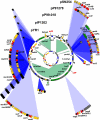Comparative genomics of the IncA/C multidrug resistance plasmid family
- PMID: 19482926
- PMCID: PMC2715731
- DOI: 10.1128/JB.00189-09
Comparative genomics of the IncA/C multidrug resistance plasmid family
Abstract
Multidrug resistance (MDR) plasmids belonging to the IncA/C plasmid family are widely distributed among Salmonella and other enterobacterial isolates from agricultural sources and have, at least once, also been identified in a drug-resistant Yersinia pestis isolate (IP275) from Madagascar. Here, we present the complete plasmid sequences of the IncA/C reference plasmid pRA1 (143,963 bp), isolated in 1971 from the fish pathogen Aeromonas hydrophila, and of the cryptic IncA/C plasmid pRAx (49,763 bp), isolated from Escherichia coli transconjugant D7-3, which was obtained through pRA1 transfer in 1980. Using comparative sequence analysis of pRA1 and pRAx with recent members of the IncA/C plasmid family, we show that both plasmids provide novel insights into the evolution of the IncA/C MDR plasmid family and the minimal machinery necessary for stable IncA/C plasmid maintenance. Our results indicate that recent members of the IncA/C plasmid family evolved from a common ancestor, similar in composition to pRA1, through stepwise integration of horizontally acquired resistance gene arrays into a conserved plasmid backbone. Phylogenetic comparisons predict type IV secretion-like conjugative transfer operons encoded on the shared plasmid backbones to be closely related to a group of integrating conjugative elements, which use conjugative transfer for horizontal propagation but stably integrate into the host chromosome during vegetative growth. A hipAB toxin-antitoxin gene cluster found on pRA1, which in Escherichia coli is involved in the formation of persister cell subpopulations, suggests persistence as an early broad-spectrum antimicrobial resistance mechanism in the evolution of IncA/C resistance plasmids.
Figures


References
-
- Anisimov, A. P., and K. K. Amoako. 2006. Treatment of plague: promising alternatives to antibiotics. J. Med. Microbiol. 551461-1475. - PubMed
-
- Aoki, T., S. Egusa, Y. Ogata, and T. Watanabe. 1971. Detection of resistance factors in fish pathogen Aeromonas liquefaciens. J. Gen. Microbiol. 65343-349. - PubMed
-
- Burrus, V., and M. K. Waldor. 2004. Shaping bacterial genomes with integrative and conjugative elements. Res. Microbiol. 155376-386. - PubMed
Publication types
MeSH terms
Associated data
- Actions
- Actions
Grants and funding
LinkOut - more resources
Full Text Sources
Other Literature Sources

